A Lecture presented by Margarita Gómez Galvarriato at “Tech 4 Dev 2014”: an international bi-annual conference on technology for development held by the UNESCO chair at the E.P.F.L. in Switzerland.
Human population continues growing and concentrating in urban areas where even drinking a glass of water becomes a highly technological act. Many of the new urban dwellers of the world cannot access the technologies needed to fulfill basic needs or the essential technologies.
In Mexico City “informal settlements” are sixty percent of its total households. These settlements have developed beyond the limits of urban planning and regulations, and often on unsuitable areas with no access to basic urban services. They face acute water scarcity problems but are rich in inventive low-cost solutions to cope with it.
Rational water use is an everyday reality for the people living in these “informal settlements”. Water-saving practices and alternative water resources are currently used when water becomes scarce. This study aims to assess water saving practices currently used in a case study area with the purpose of detecting opportunities to develop low-cost technologies with interesting potentials that can make the practices desirable and practical even when acute scarcity is no longer an issue.
Introduction and Purpose
Ecological Footprint (EF) data tells us that, given current population and available land area, an Ecological Footprint of less than 1.8 global hectares per person makes a country’s resource demands globally replicable.The United Nations’ Human Development Index (HDI)—which measures a country’s average achievements in the areas of health, knowledge, and standard of living—tells us that an HDI higher than 0.8 is considered “high human development.” (Global Footprint Network 2011).
High human development for everyone within a global Ecological Footprint of less than 1.8 global hectares per person would mean moving beyond poverty without compromising resource sustainability. The Global Footprint Network compares these two indicators for different countries.The countries closest to the goal are both developed countries where education and sustainble technology let maintain lower resource needs with good standards of living, and developing countries where HDI is progressing and EF is still close to the goal.
Mexico and other Latin-American countries are within these last countries. In these countries wealth is not evenly distributed. While the upper classes have higher living standards and are important resource users, the lower classes level the average resource use by living below minimum wealth standards.
The technology in use today in low EF developed countries is too expensive and can be too complex to be introduced into less educated and poorer communities, and low-cost devices tend to be high resource consumers because of their older technologies or their shorter durability.
If we were able to develop the affordable technologies needed to exit precarious conditions without multiplying resource use, people who restrict resource use because of these conditions could access higher development levels without becoming high resource users and we would reach our development goal.
In Mexico City’s informal settlements people somewhow get along with very low water availabilty. We observed, for example, that white school uniforms children wore for school on mondays were impecable even when we knew that households were receiving limited amounts of water through water tankers provided by the city’s authorities. Therefore, we conducted a study aiming to assess the water-saving practices used to fulfill their basic needs, hoping to detect low-cost technology development opportunities.
Design and Methods
Working through a local non-profit organization (Isla Urbana), we interviewed community members in the « Ajusco Medio » area to document their water-saving practices. « Ajusco Medio » is located in the south-western foothills’ periphery of Mexico City. The amount of water used with these practices was calculated and compared to the average use per person and per day in the region (« Tlalpan Ward ») to obtain their water-saving potential. These practices were also compared to water-saving devices that exist in the Mexican market.
The following water-practices were observed:
- Water-saving showerhead.
- Dual-flush WC.
- Body washing using a 19 lt. water bucket.
- Introducing a large plastic bathtub into the shower to collect water for reuse.
- Recuperating wash and rinse water from automatic clothes washing machines and reusing it for a second wash: The first wash consists on light-colored not too dirty clothes, the second of darker clothes. A third wash consisting of very dirty clothes is sometimes done as well.
- Recuperating laundry water at the end of the washing cycle and reusing for toilet flushing, floor cleaning and outside cleaning (particularly when dogs live outside).
The water-saving devices that were not assessed during the interviews but exist in the Mexican market and were considered in the comparison are the following:
- “Grado Ecológico” label showerheads. (Up to 3.8 lt./min. water flow)
- per flush toilets (Within current Mexican regulations: Norma Oficial Mexicana).
- “Grado Ecológico” label toilets. (5 lt. per flush).
- Dry toilets.
- Low-water use clothes washing machines.
We used the average water use in “Tlalpan Ward” of 120 lt. per person per day as the comparison benchmark (Tlalpan 2012). In order to calculate the part used at every particular point, we used Mexico’s average domestic water use table (Ortíz Monasterio 1991). We assumed an average use of 48 liters per person per day for toilet flushing, 30 liters per person per day for showers, 18 per person per day for Laundry and 24 liters per person per day for cooking, cleaning and other uses. (Fig. 1).
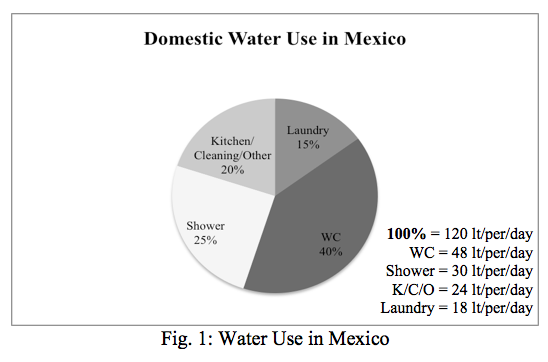
We looked for appliances and devices that used the most similar amount of water per person and per day as the calculated average for “Tlalpan Ward”. Showers were classified in: Regular showerheads, which are all the ones that do not comply with the Mexican Norm limit for shower flow (10 lt./min.), Mexican Norm limit Showers, which are those that use up to 10 lt./min. but do not comply with the “Grado Ecológico” Label limit (3.8 lt./min.), and finally “Grado Ecológico” label showers. (Laboratorio Profeco 2011) We chose a five minute shower using a “Grado Ecológico” label shower head (30 lt per shower) as our average benchmark. (Table 1).

To obtain our benchmark toilet, which corresponds to the average Tlalpan toilet water use of 48 lt/person/day, we searched for the water use of toilets offered in the Mexican market. (CONAGUA 2010). We found that our benchmark corresponds roughly to a ten-year old (or older) toilet used four times a day. (Table 2).
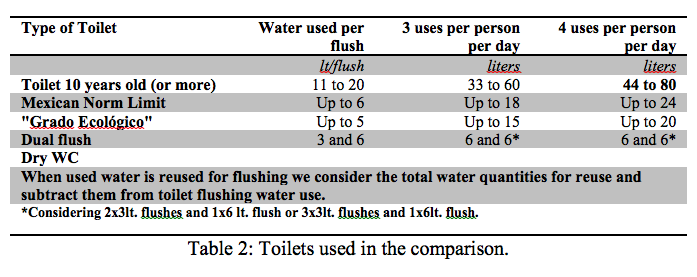
Clothes Washing machines were classified taking into account their water use per full cycle and their Mexico City minimum price. (Laboratorio Profeco 2007). (Table 3).
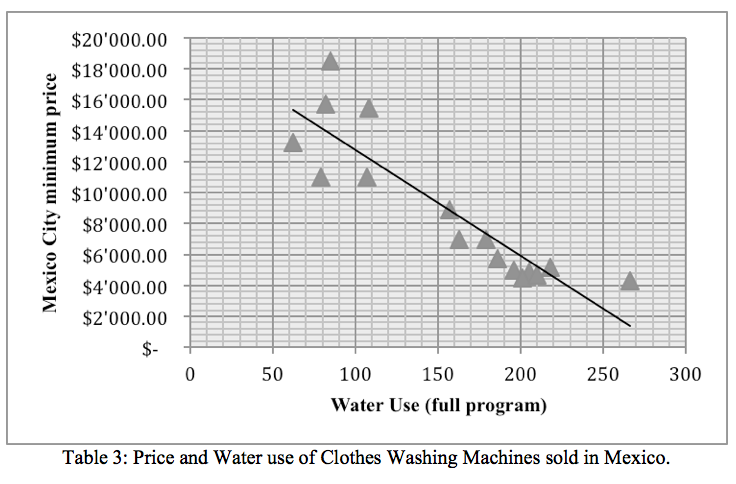
We assumed three full clothes-washing cycles per household per week and divided them between the average household members in our study (four). For the comparison we used the lowest water-consuming machine, which is also the most expensive (Daewoo DWC-ED1212), the most affordable washing machine (Samsung WA15L5W) and machine in the middle of our list where laundry water is not reused (Frigidaire GLWS1749AS), which corresponds to the Tlalpan average laundry water use of 18 lt./person/day. (Table 4).

Rainwater autonomy after the last rain episode was calculated dividing full capacity of the cistern between the water needs of all the household members.
Results
We found that the use of a “Grado Ecológico” showerhead for a five-minute-long shower uses the same amount of water as using a 19lt. bucket to shower manually, both of these shower methods are the most water sparing in our study. All the water-saving practices assessed in the Case Study area and in the Mexican market that exceed the water-saving potential of 50% compared to the average Tlalpan water-use of 120lt./person/day, include either of these shower water-saving practices.
The use of any of the water-saving practices individually has little impact. The simultaneous use of these practices in the most water-consuming points of the house produce the best performances.
The most important water-saving potential is 58% and it is achieved through combining the “Grado Ecológico” showerhead (five minute shower) or 19lt. bucket shower, a dry toilet and the most water-saving clothes-washing machine we researched (Daewoo DWC-ED1212). Other than the 19 lt. bucket shower, these technologies are not currently used in the study area. This potential is followed closely (56% and 52% respectively) by the same shower and toilet options but exchanging the Daewoo DWC-ED1212, which is also very expensive, for the average (Frigidaire GLWS1749AS) and least expensive (Samsung WA15L5W) washing-machines in the study when water is used two times.
Several practice combinations share a 51% water-saving potential. All of these combinations include one five-minute daily shower using a “Grado Ecológico” showerhead or 19lt. water-bucket and Dual-Flush toilets when flushed reusing the laundry water, however, reusing laundry water manually makes it impossible to use the dual-flush system. The most water-saving clothes-washing machine without reusing washing water and the average or least expensive clothes-washing machines if using washing and rinsing water twice have the same performance. When these last combinations are made using “Grado Ecológico” toilets instead of Dual-Flush ones the water-saving performances come down to 47%. (Table 6)
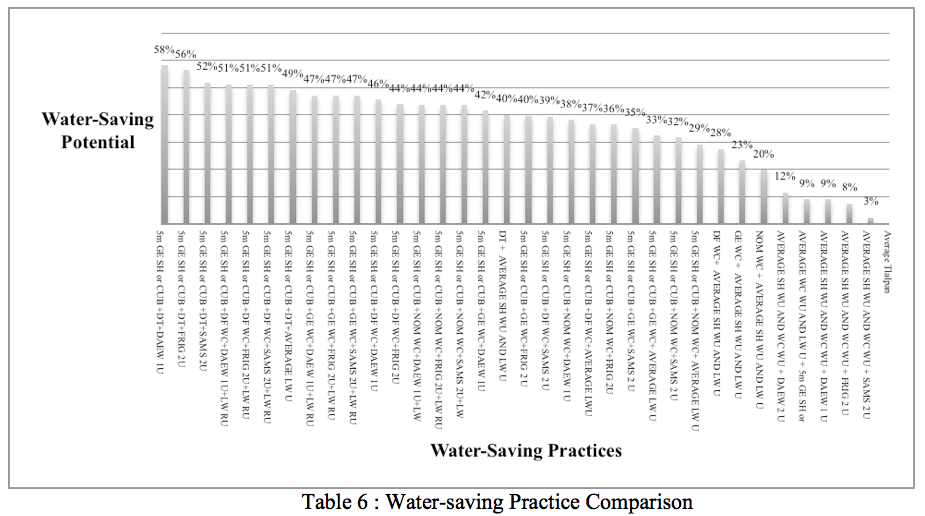
We noticed containers filled up with different-quality water waiting to be reused for suitable practices. We observed that the houses’ architectural programs are influenced by water-reuse because points where reusable water is produced and reused lay next to each other in order to avoid carrying heavy water loads around. (Fig. 2).
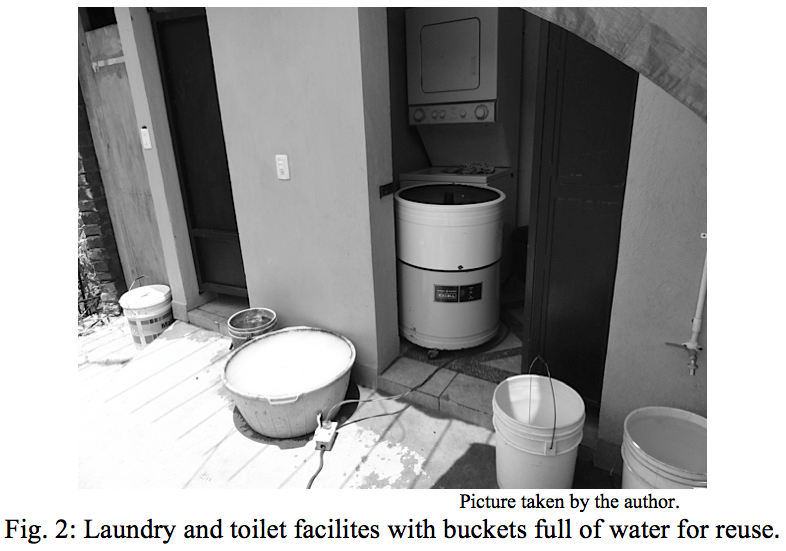
Conclusions
We found a number of water-saving practices in the case study area.The water-saving potential of their combined use is considerable for it can divide the average water use in half. These local low-cost practices have water-saving performances that are not very different from performances obtained with more expensive and high-tech options that are present in the Mexican market, but impose certain constraints. There are opportunities to develop low-cost technologies that reduce the existing constraints or to create programs that could place existing high-tech options within reach for the most economically challenged.
In our study, we found out that people in the community use innovative and low-cost water saving practices. The points of use where the most water is used (WC, shower, laundry), were the same where most of the water-saving practices were implemented. These practices are accepted by stakeholders as long as water scarcity is present, because they impose health and practical constraints (e.g. carrying loads of water around the house, stocking used graywater for more than 24 hours), therefore, they are socially, culturally environmentally and economically accepted, for as long as water scarcity rests accute.
Some of the interviewed households have already installed a rainwater harvesting system and they report they use it as their only water source during the four months of the rainy season. They fill their cisterns with water from the grid or with water tankers through the dry season. Except one, all of these households reuse clothes washing water at least once but they no longer use other water-saving methods. Some of the households that have installed the rainwater harvesting system are not able to fulfill their water needs, we think it is because of their higher member numbers. If rainwater harvesting systems were combined with the use of water-saving practices, the reported four-month autonomy from grid water could be enhanced to almost seven months without enlarging the cistern capacity.
Dry toilets offer good water-saving perfomances but were not present in our assessment. Even when they also offer the possibility to adequaltely dispose of human organic waste and to produce fertilizer, they involve strong community organization and motivation. In order to sustainably use dry-toilets, treatment and reuse of the organic excreta is compulsory and the existance of a motivated community organization is a prerequisite. Past experience with these devices in the case study area were not succesful. Keith Pezzoli documents a Productive Ecological Community Project (CEP for its spanish initials) that aimed to introduce an Integrated System for Organic Waste Recycling that inculded the use of dry toilets and the transformation and reuse of organic waste. He argues that « even when many important factors were in place, such as local social and cultural capital in the form of self-organized community structure, community access to technological knowledge for social experimentation and social learning and environmental resources including productive land and water, there was little real support from the state…The calls for alternative, collective (land) tenure arrangements that were part of the project were denounced as subversive » (Pezzoli 1998). Nevertheless, knowing that toilets are the most important water-use points in the house, a waterless option remains of great interest for as long as the appropriate technology, community organization and state support can be put to work together.
Consumers in the case study area use the most affordable low-tech solutions to deal with water scarcity. We assume this is a choice a “necessity” because we noticed it is no longer used when water security is obtained. Given their economical capacity, even if they knew they could exchange their laundry water reuse methods for a high-tech low-water-using washing machine they could not afford to change it. The machines we observed in our visits were not new and many had been adapted and repaired locally, therefore we assume that within the community the technological capacity to fully adopt these older appliances exists.
For the people in the community to afford high-tech options when exiting water scarcity stages, subsidies and proper educational programs would be needed if lower tech and cost options could not be developed. However, sixty percent of Mexico City’s households are in informal communities, therefore, a market for low-cost water-saving technology exists. We believe there is an important opportunity to develop these technologies at the community’s scale that could then be adapted for the region’s and even the country’s scale.
« Comision Nacional del Agua » has created a low energy and water using label for washing-machines also called « Grado Ecológico »(CONAGUA 2010). The most important appliance manufacturers and distributors have started the process of adapting and producing washing-machines under that norm. We are hoping they can come out with some affordable options and that their susbsitution programs include economical and technological acessibility assistance for the base of the pyramid sector.
Knowing that water resources in Mexico City are not multiplying and human population keeps growing, It is of everyone’s interest to keep water needs as low as proper standards of living permit. We believe that developing low-cost technology in order to eliminate constraints in the most simple way, can make the practices appropriate and let rational water use continue when water availablity security is attained.
We believe that the water-saving methods commonly used in the community can be adpated gradually into low-cost water economic technology keeping in mind that the driving force is the possibility to attain water availability all year round as well as confort, ease and healthiness of use. This ease, in terms of price, security and confort is the key to low water use without scarcity.
Margarita Gómez-Galvarriato Freer (Université Catholique de Louvain, Belgium)
Brief biography of presenting author: With a background in Architecture from Universidad Iberoamericana, Mexico City and in Architecture and Sustainable Development from EPFL, and UCL (Catholic University of Louvain), I have developed architectural design projects aiming to the creation of humane and sustainable spaces. I am currently working on a PHD research project on Sustainable Water Use in Informal Settlements in the Ajusco region of Mexico City at UCL. Part of this project is done through “Isla Urbana”, a local non-profit organization that has developed and installed Rainwater-Harvesting Systems in the region.
Presenting author’s email address: mggf@mac.com
Session Number: TH1-SE01-01
Keywords: water-saving practices, informal settlements, essential low-cost technology, sustainable water use, water reuse
References
CONAGUA (2010). Conference given by Ing. José Luis Luege Tamargo, General Director of Comisión Nacional del Agua. Resource Document. http://www.conagua.gob.mx/CONAGUA07/Conferencias/CONFERENCIA%20JLLT%2020-01-10.pdf Accesed September 2013.
Global Footprint Network (2011). Our Human Development Initiative. Resource Document. http://www.footprintnetwork.org/en/index.php/GFN/page/fighting_poverty_our_human_development_initiative/ Accesed September 2013.
Laboratorio Profeco (2007). Lavadoras de Ropa Automáticas. Resource document. Laboratorio Nacional de Protección al Consumidor, http://www.profeco.gob.mx/revista/pdf/est_07/lavadoras.pdf. Accessed September 2013.
Laboratorio Profeco (2011). Estudio de Calidad: regaderas para aseo corporal. Resource document. Laboratorio Nacional de Protección al Consumidor, Revista del Consumidor, March 2011, http://www.revistadelconsumidor.gob.mx/wp-content/uploads/2011/03/pdf-regaderas.pdf. Accessed September 2013.
Ortíz Monasterio, F. (1991). Contaminación en la Ciudad de México. México City: Milenio.
Pezzoli, K. (1998). Human Settlements and Planning for Ecological Sustainability. The Case of Mexico City. Cambridge, Massachussetts: MIT Press.